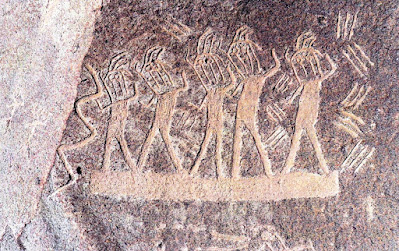A huge number of petroglyphs can be found at a site called Toro Muerto in Peru. Although Toro Muerto is one of the largest rock art sites in Peru it has not been extensively studied. Recently a team of archeologists has published studies of the rock art of Toro Muerto. Andrzej Rozwadowski, Liz Gonzales Ruiz and Janus Z. Woloszyn published a paper in 2019 covering the rock art of Toro Muerto in general, and then in 2024 Rozwadowski and Woloszyn followed that with an analysis of the themes on some of the boulders as dancers and representations of the music accompanying the dancers.
“Toro Muerto, meaning ‘dead bull’ in Spanish, is a significant rock art complex located in southern Peru, nestled within a desert gorge near the Majes River Valley. Encompassing and expansive area of approximately 10 square kilometers (3.86 sq mi), this site holds around 2,600 volcanic boulders, each adorned with ancient petroglyphs. These petroglyphs vary in size and complexity ranging from small stones featuring single motifs to massive boulders adorned with intricate arrays of multiple images.” (Pandey 2024)
“Unique to the Toro Muerto petroglyphs are the drawings of the so-called "danzantes" or dancers. A danzante is a schematic drawing of a human figure, usually 20-30 cm high, often depicted in a dynamic pose with one arm raised and the other lowered, legs slightly apart (sometimes bent at the knees), and the head presented in profile or facing forward. While the geometric patterns, lines, and zigzags accompanying the danzantes were initially thought to represent snakes or lightning bolts, Polish scientists who analyzed these 2,000-year-old rock carvings have proposed a different theory.” (Waters 2024) On 15 April 2012, I wrote a column on RockArtBlog about Dancing Figures in rock art (Faris 2012). At that time I had not yet seen any of these marvelous petroglyphs at Toro Muerto.
“A new study published in the Cambridge Archaeological Journal proposes a novel interpretation: the abstract geometric shapes adorning the volcanic boulders might be representations of ancient songs potentially linked to shamanic rituals involving hallucinogenic plants.” (Radley 2024) I would think that this implies a strange twist on the neuropsychological model, stating that the petroglyphs represent visions seen accompanying music during hallucinations.
“It is worth noting that Antonio Núñez, Cuban ambassador to Peru and one of the most important early researchers of Toro Muerto, suggested that some of the geometric motifs he observed at this site (zigzags, straight lines, points) represent ‘musical or dance signs’ (signos musicales o danzarios), or ‘sound communication’.” (Rozwadowski and Woloszyn 2024)
So, the idea that the lines, zigzags, etc., represented music that the anthropomorphs are dancing to has been considered a possibility since these petroglyphs were first studied. When I first saw the pictures I was struck by their resemblance to Laban diagrams invented to record dance movements. This is officially known as “Laban Movement Analysis." “LMA is largely taken from Rudolph Laban’s ‘The Mastery of Movement,’ first published in 1950. A choreographer and dance theorist hailing from Austria-Hungary, Laban was a pioneer of modern dance as we know it today. - - He also created intricate taxonomies for understanding human movement, such as labonotation, a theory of dance notation and analysis.” (Woltmann 2022) Now, I am not suggesting that these petroglyphs that accompany the ‘dancers’ are actually something like a Laban diagram, but I find the resemblance to be striking, a fascinating coincidence.
NOTE: Some images in this posting were retrieved from the internet with a search for public domain photographs. If any of these images are not intended to be public domain, I apologize, and will happily provide the picture credits if the owner will contact me with them. For further information on these reports you should read the original reports at the sites listed below.
REFERENCES:
Faris, Peter, 2012, Dancing Figures, 15 April 2012, https://rockartblog.blogspot.com/search/label/Dancing%20figures.
Pandey, Sahir, 2024, Are Toro Muerto’s Petroglyphs in Peru Hallucinogenic Visions in Stone, 10 April 2024, https://www.ancient-origins.net. Accessed online 25 May 2024.
Radley, Dario, 2024, Geometric petroglyphs in Peru may represent ancient songs from shamanic rituals, 8 April 2024, https://archaeologymag.com. Accessed online 9 April 2024.
Rozwadowski, Andrzej, and Janus Z. Woloszyn, 2024, Dances with Zigzags in Toro Muerto, Peru: Geometric Petroglyphs as (Possible) Embodiments of Songs, pp. 1-21, published online by the Cambridge Archaeological Journal on behalf of the McDonald Institute for Archaeological Research, Cambridge, UK. Accessed online 13 May 2024.
Waters, Connie, 2024, Ancient Petroglyphs In Toro Muerto Are Not What We Thought – Archaeologists Say, 24 May 2024, https://ancientpages.com. Accessed online 24 May 2024.
Woloszyn, Janus Z., Liz Gonzales Ruiz, and Andrzej Rozwadowski, 2019, The Petroglyphs of Toro Muerto: new documentation and discoveries at the largest South American rock art complex, pp. 1-8, Antiquity, Vol. 93, No. 372. https://doi.org/10.15184/aqy.2019.200. Accessed online 14 May 2024.
Woltmann, Suzy, 2022, Laban Movement Analysis: An Introduction for Actors, 18 July 2022, https://backstage.com/magazine/article/laban-movement-analysis-guide-50428.
Accessed online 26 June 2024.

.jpg)









No comments:
Post a Comment